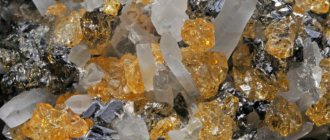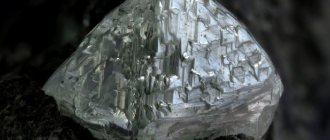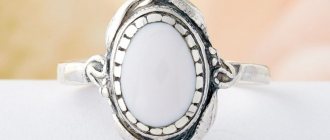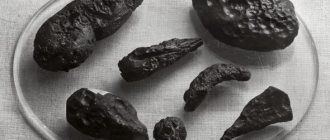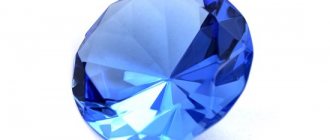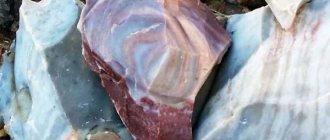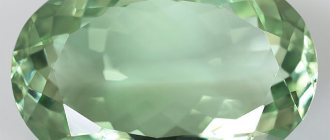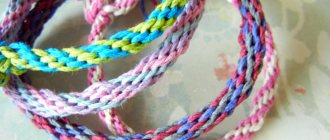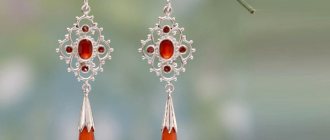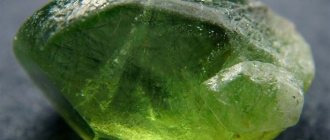History and origin
Cubic zirconia is a human creation and the triumph of technology in copying natural processes. The fate of the stone and its name is a plot for a detective story.
cubic zirconia
What is cubic zirconia
The crystals are obtained from zirconium dioxide. When processed, they almost copy a diamond in external and physical parameters, which is why in the Soviet Union artificial diamonds were called cubic zirconia.
There is a natural mineral of comparable qualities - tazheranite, found in the Tazheran Gorge near Lake Baikal. But its crystals are small, like jewelry, and are not used.
How it appeared
It was obtained artificially in the 1960s by physicists from the Lebedev Physical Institute of the Academy of Sciences. They called it by its first letters - FIANit.
Scientists experimented with a composition for the production of laser equipment, and the shiny material was considered defective production waste. Institute staff sorted the stones into souvenirs.
Enterprising citizens “helped.” Having brought the raw materials to marketable condition, they established sales to the West. At first they were delighted with the cheap “diamonds”. Then a scandal broke out and an investigation began. The traces led to the USSR.
The story was hushed up. The Europeans were uncomfortable with being fooled by the “backward Russians.” A limited circle of people in the Union knew about this, since the activities of FIAN were not advertised.
The party gave the task to scientists to create colored analogues of the stone for sale as jewelry. It was, of course, fulfilled; transparent multi-colored crystals at prices affordable for citizens filled jewelry stores. There was even a plan to release the stones.
Name confusion
The term “cubic zirconia” is used in the territory of the former USSR and Eastern Europe (former socialist countries). In the rest of the world, the material is known as zirconite, shelby, cubic zirconia, jevalite, and daimonsquay.
Sometimes cubic zirconia is called zircon or zirconium. But these are different things:
- cubic zirconia - synthetic, imitation diamond;
- zircon is an independent yellow-brown mineral;
- zirconium is a chemical element.
Misunderstandings arose because not everyone in the world wants to recognize the country's authorship. They also cannot forgive the embarrassment of half a century ago.
Let's look at the names
We bought a nice ring or earrings abroad, and the tag says CZ (Cubic Zirconia). This "cubic zirconia" means that the cubic zirconia insert is not a gemstone.
We recommend: CHIC, SHINE, BEAUTY | How to grow NANO-SAPHIRE
In general, poor cubic zirconia is insulted by all and sundry. Zirconium cube, zircon, zirconium - as many names as they called it. But the creators gave their invention a name - cubic zirconia. That's what you call it.
- Zircon is a mineral.
- Zirconium is a metal.
- Cubic zirconia (zirconium dioxide) is a crystal obtained artificially.
Abroad, cubic zirconia is called:
- Diamond Sky;
- zirconite;
- jevalit;
- cubic zirconium (Cubic Zirconia);
- shelby
Wits call it “the poor man’s diamond.”
Physicochemical characteristics
Cubic zirconia is an artificial material. The basic chemical formula of zirconium dioxide is changed by the components introduced during the synthesis of crystals.
cubic zirconia
The material is unstable, therefore it is supplemented with oxides of calcium, yttrium, and manganese. The structure of the crystal lattice and appearance resembles a diamond.
| Formula | Zr0.8Ca0.2O1.92 |
| Color | Yellow, orange, red, green, purple, pink, golden brown |
| Shine | Diamond |
| Transparency | Transparent |
| Hardness | 7,5—8,5 |
| Cleavage | Absent |
| Kink | Uneven |
| Density | 6.5-10 g/cm3 |
Production
The stones are synthesized using high-frequency melting. Process description:
- The raw material (powdered zirconium oxide) is loaded into a container.
- A high-frequency generator supplies energy that melts the inside.
- Water circulating through the tubes prevents the temperature from rising above room temperature, so the outer layer of the substance remains cold and solid.
- The melt cools to room temperature.
- Columns 2 cm high and 2 cm in diameter are removed from the solid core.
The cycle is short: crystals grow by 8–10 mm per hour.
This is Soviet technology. It was invented by scientists, whom the state did not restrict in the use of resources. It is problematic for market conditions; even countries that bought it or received it from the USSR are simplifying production. But the resulting material is not cubic zirconia.
The cheapest are translucent, colorless or transparent crystals. Colored ones are more expensive: the external resemblance to precious gems is ensured by metal oxides and the subtleties of the process. The most expensive ones are multi-colored and imitation diamonds.
Application area
Surprisingly, fionite is a stone whose properties were intended for technical use, but today it is mostly produced for jewelry purposes.
Jewelry
Fionite – a precious stone or not? No, but in jewelry they have learned to produce high-quality stones that are almost identical to diamonds. They are produced in small batches and are intended for accessories that are not that cheap . Wealthy people can purchase them to replace real diamond jewelry for everyday wear.
Lesser-quality, small-sized gems are inserted into jewelry sold in jewelry chains at affordable prices.
How else is cubic zirconia used?
The mineral has found application in some industries:
- It is used to produce heating elements for devices due to their ability to conduct current.
- Used in radio engineering.
- When heated, it can become an electrolyte and transport oxygen ions. This property is used in analyzers and fuel cells.
- The high melting point (more than 2700 °C) and transparency make zirconium oxide the basis of refractory materials: glass, ceramics, enamel.
- High hardness makes it possible to replace expensive diamonds when grinding and cutting in the metalworking industry.
- Used for the manufacture of optical instruments.
- In medicine, it is used in dentistry and for the production of scalpels for microscopic operations.
Price
Artificial stone is produced in large volumes and is therefore very cheap. The wholesale price for a package of colorless minerals will cost a jewelry manufacturer $15–20 . Colored stone, the price of which is about $15 per gram , is purchased in smaller quantities.
View this post on Instagram
Posted by Golden_Style (@golden_style_almaty) Sep 24, 2021 at 11:42 PDT
In the finished product, the final price is determined not by cubic zirconia, but by the precious metal and production costs.
Varieties and colors
The description of cubic zirconia always includes color.
The classic stone is colorless. It is not a problem for technologists to create an example of almost any color, including three-color cubic zirconia.
The shade of the stone is created by the base substance:
- yellow - copper;
Yellow cubic zirconia - brown - titanium;
Brown cubic zirconia - pink range - erbium;
Pink cubic zirconia - red gamma - neodymium;
Red cubic zirconia - green - chrome.
Green cubic zirconia
For blue shades, use cobalt or aluminum. A lavender color is obtained, which natural stones do not have. But imitation of emerald color for cubic zirconia is still unrealistic. The maximum is a resemblance to chrysolite in golden-green shades.
In jewelry, the crystal duplicates precious stones of the first or second row:
- blue - topazes;
- green - chrome diopside;
- yellow - citrine;
- golden - chrysolite;
- red - garnet or ruby;
- blue - sapphire;
- purple - amethyst;
- black - carbonado.
Stones change color in daylight and artificial light. Comparable in luster to alexandrites, transparent yellow, green or brown samples become black or white after heat treatment.
Cleaning the decoration
Caring for an artificial diamond is simple, but necessary. By their nature, cubic zirconias are capable of accumulating, “collecting” dust, dirt, and traces of grease. Therefore, it will be better if, after removing the jewelry, you wipe it with a napkin moistened with alcohol or vodka (a jewelry napkin is even better).
We recommend: MAJORICA PEARLS from the hot island
Important: before using alcohol, check to see if the color is washed off. Some technologies for adding color to cubic zirconia involve spraying rather than painting the entire color of the stone.
Keep your jewelry in a separate case to prevent the stones from getting scratched.
If you are going to clean up the house, take off the decorations. Chemicals are harmful to them.
You can clean products with cubic zirconia with soapy water and then rinse with clean water. Dry with a napkin and put in the case.
In order for a stone in a piece of jewelry to shine brightly, it must be taken to a jeweler at least once a year for professional cleaning. And at home, after washing and drying, polish with suede.
Medicinal properties
Cubic zirconia has a dual nature - a natural base and a “diamond” structure, but an instant, by nature’s standards, creation process. Its medicinal and magical properties give rise to controversy.
Lithotherapists who are fans of the stone believe that it heals the body. From it comes the energy accumulated by the base substance plus received during creation.
cubic zirconia
Contemplation of the stone improves mood, giving strength to recover from a nervous shock, serious illness or surgery.
Magic properties
Esotericists have established the ability of a stone to return to its owner the emotions or energy received from it. Therefore, when communicating with cubic zirconia, you need to be positive.
The magic of the stone is consonant with a person of any age, gender or profession. But this is the patron saint of scientists and creative people. The properties of cubic zirconia are useful for those who want to do a lot at once: visit more countries, perform at several concerts or performances. A ring or pendant is suitable for a person who works with large amounts of information.
The magical mission of cubic zirconia is to bring joy. And how can you not be happy when you buy a stone that is indistinguishable from an elite diamond or ruby? Subconsciously, the owner of the jewelry begins to believe in himself, set high goals and reach a new level of life.
The magical properties of the stone are useful for timid people with low self-esteem. Mercantile or impudent people are confident in his patronage. But it is advisable not to overdo it: the pebble will return unkind thoughts to the owner.
Who is suitable according to their zodiac sign?
Any zodiac sign can use an artificial stone.
cubic zirconia
Astrologers say that the magical properties of colored cubic zirconia are distributed according to the elements:
- Water (Pisces, Cancer, Scorpio) - white or blue;
- Air (Gemini, Libra, Aquarius) - rich yellow;
- Earth (Taurus, Virgo, Capricorn) - green or black;
- Fire (Aries, Leo, Sagittarius) - red stones.
Crystals are recommended for Aries, who will reduce the degree of emotions and temper.
| Zodiac sign | Compatibility |
| Aries | +++ |
| Taurus | + |
| Twins | + |
| Cancer | + |
| a lion | + |
| Virgo | + |
| Scales | + |
| Scorpion | + |
| Sagittarius | + |
| Capricorn | + |
| Aquarius | + |
| Fish | + |
(“+++” – fits perfectly, “+” – can be worn, “-” – is strictly contraindicated)
Compatibility with other stones
According to the horoscope or energetically, an artificially created stone does not conflict with any gems.
Jewelry with cubic zirconia and other stones
Application area
Cubic zirconia was created for technical purposes; it is not a precious stone, but its main area of application is jewelry. From abroad, stones come as zircons or cubic zircons.
Jewelry
This is a godsend and salvation for jewelry lovers for whom diamonds are financially inaccessible. A high-quality diamond cut has a high lower part and an almost flat upper part. This kind of cubic zirconia is expensive and is produced in small batches.
Price
Jewelry brands and workshops purchase crystals in bulk. A package of one hundred medium-sized stones costs $10–15 (the price of an average quality diamond is up to $5 thousand per carat).
The cost of cubic zirconia in the shades “ruby”, “sapphire”, “blue topaz” is twice as expensive as the standard ones. A good quality stone of 1.95 carats, 7x5 mm, is valued at $5, that is, the price per gram is about $12.
The price of products is determined by the precious setting, not the stone.
Ring with red cubic zirconia
Gold (585th standard):
- engagement ring with cubic zirconia - up to $100–120;
- stud earrings – $45–75, dangling earrings – $220–350;
- pendant - from $20.
Silver (925 standard):
- ring – $25–75;
- pendant earrings – $150;
- pendant - from 10 $.
Buying stones as raw materials or without a setting is unprofitable: the finished product is 13–18% cheaper.
Prices allow you to purchase jewelry as a set. Even celebrities don’t shy away from this.
Who is it suitable for?
Wear jewelry with a stone at any time of the day. Silver ones are appropriate during the day and in the office, gold or platinum are attributes for formal, important or evening outings.
- Earrings or a pendant with pink cubic zirconia are suitable for a young girl.
- A multi-color crystal set in a brooch will soften the severity of a business suit.
- A signet made of white gold or platinum with a black stone is a worthy men's accessory. A brutal option is a steel frame.
The metal of the frame of an item determines whether it is a jewel or costume jewelry.
Ring with pink cubic zirconia
In the second case, the crystals are framed with cupronickel, jewelry alloy or steel. This is a youth option.
What to consider when choosing a product
The number and dimensions of stones create a varied effect:
- a single large cubic zirconia insert in the product emphasizes the sophistication of the image;
- a scattering of stones makes the decoration an original universal addition;
- in a product where a large gemstone plays the “first fiddle”, and small cubic zirconias complement it, the gemstone looks more expensive.
White cubic zirconia crystals can be combined with gold of any shade.
The stone looks advantageous in a rhodium-plated setting: its shine is enhanced and refined.
How much does cubic zirconia cost?
How much does cubic zirconia cost and what offers are there on the market? This question is often asked on forums or to professional jewelers. A medium-sized stone, weighing up to three carats, can be bought very cheaply. For 100 pieces they ask for 10-15 dollars. In addition, the cost of cubic zirconia can be influenced by a number of factors:
- Color. The highest price is for stones imitating rubies, sapphires, blue topazes or emeralds. It is very difficult to synthesize green or blue cubic zirconia, because such colors are 2-3 times more expensive. The price of other tones is standard.
- Size. Pebbles up to three carats cost as standard. The price of heavier minerals is determined individually; much depends on the manufacturer and what inclusions are added to the raw material for stabilization. It is important to note that the density of zirconium is higher than that of diamond. Therefore, the diameter of artificial stones will be smaller than that of diamonds of the same mass.
- Cutting method. Here the price is determined by the jeweler. Cubic zirconia can be given any shape, including the traditional diamond shape. But shapes such as a drop, a heart, or a polygon with five faces usually cost more.
- Company manufacturer. The price, although slightly, can be influenced by the technologies used to grow crystals by a particular company. The more perfect they are, the higher the quality of the stones. For example, crystals produced by Swarovski may be valued higher than those produced in China or Thailand. Cubic zirconia and its price do not differ significantly from different manufacturers.
Jewelry prices
Many are interested not only in the cost of stones, but also in jewelry that has cubic zirconia inserts. Here, a lot depends on the metal in which the mineral is set, the size and type of decoration. For example, a gold ring with one large crystal is not too expensive, approximately $100, with a scattering of stones - $150-200, and a wide ring - $250-400. Silver ring – 20-70 dollars, depending on the standard of silver, weight and number of crystals. Gold-plated silver rings usually cost 30-50% more.
Stud earrings or studs made of gold, weighing a couple of grams, will cost $50-70, and dangling earrings will cost $200-300. Thin broaches will cost about $100-150. Long pendant earrings in plain or gold-plated silver can be purchased for $150, while studs or miniature round ones can be purchased for $20-$40. A women's pendant costs less, 20-30 dollars for gold and 10-15 dollars for silver. Gold double-sided neck pendants - $40-50, silver - $20-25. It must be remembered that a product with colorless zirconium costs 2 times less. And the price of jewelry with blue or green stones is higher than with yellow, brown or red ones.
If you order a product from a jeweler, having first purchased a pebble without a frame, it will cost 15-20% more. But you can make a unique thing by choosing an individual design. For example, with a dancing faun or swimming fish. The patterns and paths made from these pebbles, butterflies, hearts, frogs, and horses look beautiful. You can even make beads on a fishing line. Congo, Trail, weaving, wreath, infinity and many others models are now popular. It all depends on the taste of the customer and his own imagination.
How to spot a fake
Of the artificial stones, cubic zirconia is considered the best imitation of a diamond, which is why they are counterfeited. The original Soviet technology is expensive. Not everyone follows it, which means the final product is of low quality.
cubic zirconia
Cubic zirconia and imitations
Stones made according to a simplified scheme are easy to recognize at home:
- a fake can be distinguished by its subdued shine (cubic zirconia shines strongly in the light);
- fake sizes up to 2 cm or larger (cubic zirconias are smaller than average or small);
- the general appearance of the imitation resembles colorless or colored glass.
The stone is characterized by a strong reflection of light from its bottom, so when viewed through the platform, almost nothing is visible behind it. You can see it better through the slightly shiny fake.
A popular “understudy” for diamond and cubic zirconia is Swarovski crystals made of glass or acrylic.
Diamond and cubic zirconia
There are several ways to distinguish a diamond from a cubic zirconia:
- drop fat on the surface - on a diamond it will remain in place, on an artificial crystal it will spread droplets;
- grease it with oil and try to attach it to the glass - only the diamond will stick;
- breathe on the sample - only cubic zirconia will fog up;
- count the facets - a diamond has at least 57.
Diamond differs from cubic zirconia in structure: natural stone has inclusions, cubic zirconia is pure.
Differences between cubic zirconia stone and diamond
In most cases, this mineral imitates a diamond. However, they have different chemical structures. Cubic zirconia is zirconium dioxide, while diamond is an allotropic form of carbon.
When purchasing a gemstone, it is better to seek the help of a professional. In order to distinguish cubic zirconia from a diamond, you will need special equipment.
A diamond has 57 facets. And its analogue has significantly fewer of them. Specialists can produce the required number of edges. However, in order for cubic zirconia to acquire the internal dual glow of a diamond, magnification and special lighting are necessary.
The weight of cubic zirconia is greater than that of a diamond. In addition, it has a higher degree of transparency. Through the artificial stone you can see the surrounding objects.
To independently determine the authenticity of a diamond, you need to apply fat to the jewelry. A real gem will hold it, but an artificially synthesized one will not.
How to wear and care
Like any stones, cubic zirconias become dirty, dull, and dark when worn. But care is not difficult.
Earrings with cubic zirconia
To make a crystal shine, the following methods are suitable:
- give it to a jeweler to clean;
- use a jewelry cleaning solution;
- soak in soapy water, rinse with clean water;
- cover the stone with toothpaste, remove the remains with flannel or cotton wool;
- dilute ammonia in water (1:6), immerse the crystal for 9–11 hours, rinse in water, dry.
The stone does not tolerate cosmetics, household chemicals, and absorbs oils. Jewelry is put on when makeup is applied. Take it off before doing housework or going to the shower.
The stone has negative characteristics. Easily scratched, vulnerable to wear and chips, and greenish-yellow hues from the sun. Over time, “clouds” appear in the crystal. The effect is known as optical degradation.
Care
Products with cubic zirconia should be wiped with a damp cloth and protected from exposure to cosmetics and chlorine. It is better to remove such jewelry while doing housework.
To extend the life of the stone, it is worth protecting it from possible scratches and mechanical damage. It is advisable to store jewelry in a closed case.
